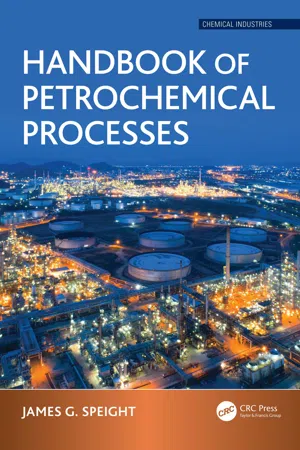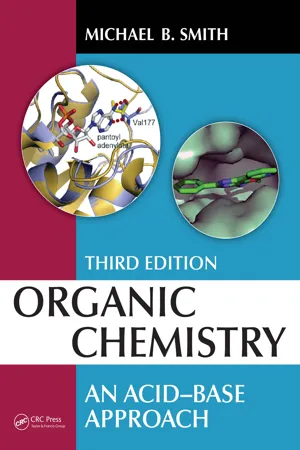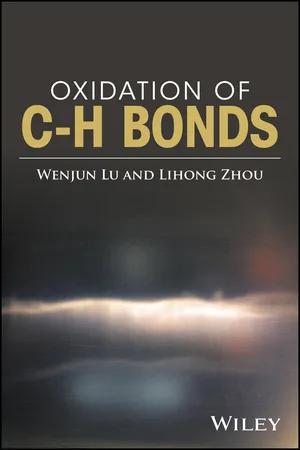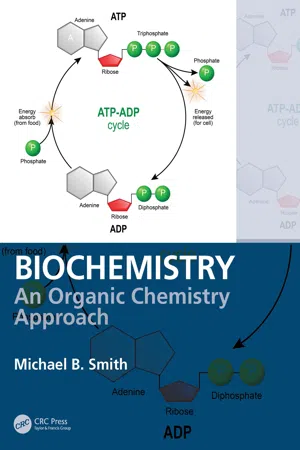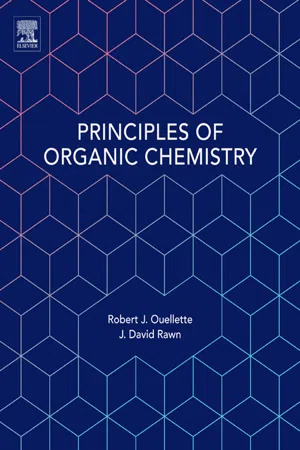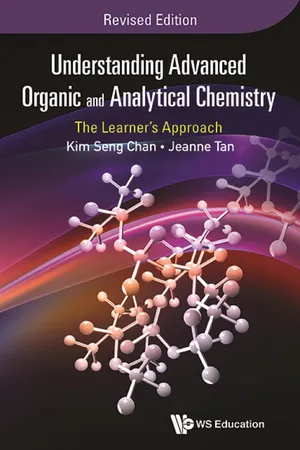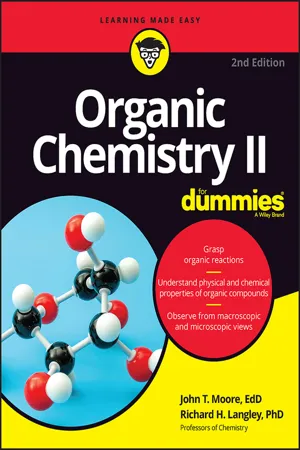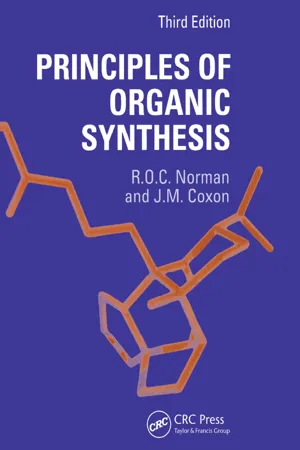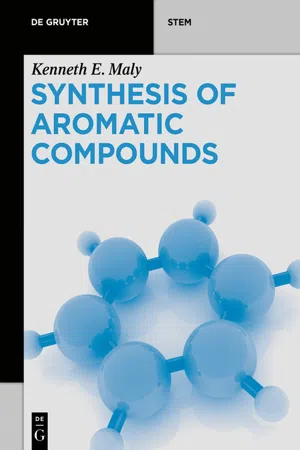Chemistry
Reactions of Benzene
The reactions of benzene involve substitution reactions where one or more hydrogen atoms on the benzene ring are replaced by other functional groups. Common reactions include electrophilic aromatic substitution, where an electrophile replaces a hydrogen atom, and Friedel-Crafts reactions, which involve the alkylation or acylation of benzene. These reactions are important in organic synthesis and the production of various chemicals.
Written by Perlego with AI-assistance
Related key terms
Related key terms
1 of 4
Related key terms
1 of 3
11 Key excerpts on "Reactions of Benzene"
- eBook - ePub
- James G. Speight(Author)
- 2019(Publication Date)
- CRC Press(Publisher)
Toluene and xylenes (methylbenzenes) are substituted benzenes. Although the presence of methyl substituents activates the benzene ring for electrophilic attack, the chemistry of methyl benzenes for producing commercial products is more related to reactions with the methyl than with the phenyl group. As an electron-withdrawing substituent (of methane), the phenyl group influences the methyl hydrogens and makes them more available for chemical attack. The methyl group could be easily oxidized or chlorinated as a result of the presence of the phenyl substituent.8.2 CHEMICALS FROM BENZENE
Benzene (C6 H6 ) is the simplest aromatic hydrocarbon and by far the most widely used one. Before 1940, the main source of benzene and substituted benzene was coal tar. Currently, it is mainly obtained from catalytic reforming. Other sources are pyrolysis gasolines and coal liquids. Benzene has a unique structure due to the presence of six delocalized pi-electrons that encompass the six carbon atoms of the hexagonal ring. Thus, benzene, a double-bond conjugated six member hydrocarbon ring, can be represented by two structures that are equivalent in energy:Benzene could be represented by two resonating Kekulé structures. It may also be represented as a hexagon with a circle in the middle. The circle is a symbol of the π-cloud encircling the benzene ring. The delocalized electrons associated with the benzene ring impart very special properties to aromatic hydrocarbon derivatives. They have chemical properties of single-bond compounds such as paraffin hydrocarbon derivatives and doublebond compounds such as olefin derivatives, as well as many properties of their own.TABLE 8.3Routes from Benzene to Other Petrochemical ProductsBenzene is used mainly as an intermediate (or starting material) to make other chemicals (Table 8.3 ), above all ethylbenzene, cumene, cyclohexane, nitrobenzene, and alkylbenzene. The predominant process is the manufacture of ethylbenzene (C6 H5 CH2 CH3 ) which is a precursor to styrene (C6 H5 CH=CH2 - eBook - ePub
- Andrew F. Parsons(Author)
- 2013(Publication Date)
- Wiley(Publisher)
7 BenzenesKey point . Benzene is an aromatic compound because the six π electrons are delocalised over the planar 6-membered ring. The delocalisation of electrons results in an increase in stability and benzene is therefore less reactive than alkenes or alkynes. Benzene generally undergoes electrophilic substitution reactions , in which a hydrogen atom is substituted for an electrophile. The electron-rich benzene ring attacks an electrophile to form a carbocation, which rapidly loses a proton so as to regenerate the aromatic ring. Electron-donating (+I, +M) substituents (on the benzene ring) make the ring more reactive towards further electrophilic substitution and direct the electrophile to the ortho -/para - positions. In contrast, electron-withdrawing (−I, −M) substituents (on the benzene ring) make the ring less reactive towards further electrophilic substitution and direct the electrophile to the meta - position.7.1 Structure
- Benzene (C6 H6 ) has six sp2 carbon atoms and is cyclic, conjugated and planar. It is symmetrical and all C–C–C bond angles are 120°. The six C–C bonds are all 1.39 Å long, which is in between the normal values for a C–C and C=C bond.
- Benzene has six π electrons, which are delocalised around the ring and a circle in the centre of a 6-membered ring can represent this. However, it is generally shown as a ring with three C=C bonds, because it is easier to draw reaction mechanisms using this representation.
As benzene has six π-electrons, it obeys Huckel's rule and is aromatic . Huckel's rule states that only cyclic planar molecules with 4n + 2 π-electrons can be aromatic: for benzene n = 1. (Systems with 4n π-electrons are described as anti-aromatic .)Naming derivatives of benzene is discussed in Section 2.4Aromatic compounds can be monocyclic or polycyclic, neutral or charged. Atoms other than carbon can also be part of the ring and for pyridine, the lone pair of electrons on nitrogen is not part of the π-electron system (Section 1.7.5). - eBook - ePub
Organic Chemistry
An Acid-Base Approach
- Michael B. Smith(Author)
- 2022(Publication Date)
- CRC Press(Publisher)
19 Aromatic Compounds and Benzene Derivatives
DOI: 10.1201/9781003174929-19The video clips for this chapter are available at: https://routledgetextbooks.com/textbooks/9780367768706/chapter-19.phpThe scientist photographs are also available at: https://routledgetextbooks.com/textbooks/9780367768706/image-gallery.phpBenzene was identified as a special type of hydrocarbon in Section 5.9. Benzene and derivatives are aromatic hydrocarbons with one ring or several rings fused together. The aromatic character of benzene and derivatives have special stability, which imparts a unique chemical profile.To begin this chapter, you should know the following points:- Resonance and resonance-stability (Sections 2.6 and 6.3.1).
- Nomenclature and structure of alkenes, alkyl halides, alcohols, amines, aldehydes, and ketones (Sections 5.1, 5.2 5.85, and 5.6).
- Carboxylic acids and carboxylic acid derivatives (Chapter 18 ).
- The structure and nature of π-bonds (Section 5.1).
- Reactivity of alkenes (Sections 10.1–10.6).
- E2 elimination reactions of alkyl halides (Sections 12.1–12.3).
- E1 elimination reactions (Section 12.4).
- The CIP rules (Section 9.2).
- Electron-releasing and withdrawing substituents (Sections 3.8, 6.3.2).
- Brønsted-Lowry acid-base reactions of alkenes (Sections 10.5–10.7).
- Carbocation stability (Sections 7.2.1, 10.1 and 10.3).
- Leaving groups (Sections 11.1–11.3 and 18.4).
- Lewis acids and Lewis bases (Sections 2.7 and 6.8).
- Rate of reaction (Section 7.11).
- Reduction of functional groups (Sections 17.2–17.5).
19.1 Benzene and Aromaticity
Structure of BenzeneBenzene is a liquid first isolated from an oily condensate deposited from compressed illuminating gas by Michael Faraday (England; 1791–1867) in 1825. Benzene is a hydrocarbon and the parent of a large class of compounds known as aromatic hydrocarbons. In 1834, Eilhard Mitscherlich (Germany; 1794–1863) established the formula to be C6 H6 and named the material benzin. Justus Liebig (Germany; 1803–1873) changed the name to benzol. In 1837, August Laurent (France; 1807–1853) proposed the name pheno (Greek; I bear light) since it was isolated from illuminating gas. The name was not adopted, but has given rise to the term phenyl for a benzene ring used as a substituent C6 H5 - eBook - ePub
- Wenjun Lu, Lihong Zhou(Authors)
- 2017(Publication Date)
- Wiley(Publisher)
9 Oxidation of Benzene9.1 Introduction
Benzene (C6 H6 ) is the basic aromatic compound having six identical aryl sp2 C─H bonds, that is, phenyl sp2 C─H bonds. Currently benzene is mainly produced from petroleum oils as raw materials through refining, catalytic reforming, or pyrolysis of gasoline [1] (Scheme 9.1 ). Benzene is used to synthesize ethylbenzene, followed by dehydrogenation to styrene monomer exclusively, leading ultimately to various materials including polystyrene, styrene–acrylonitrile copolymer (SAN), acrylonitrile–butadiene–styrene terpolymers (ABS), etc. Besides, some benzene is used to produce cumene, which is converted into phenol and acetone through cumene oxidation process and is hydrogenated to cyclohexane, followed by oxidation to adipic acid, caprolactam, hexamethylenediamine, etc. in the manufacture of nylon. Other major applications of benzene include production of nitrobenzene for aniline synthesis and linear alkylbenzenes (LABs) used as detergents, chlorobenzene, maleic anhydride (MAH), etc. However, although the commercial utilization of benzene to supply bulk chemicals such as styrene, phenol, aniline, etc. has been conducted for decades, these processes are often indirect and need multisteps. Thus, direct oxidation of phenyl sp2 C─H bond to produce important chemicals in one step is still of commercial interest currently. On the other hand, due to the prevalence of benzene core in natural products, pharmaceuticals, and functional materials, etc., efficient methods of converting benzene into universal synthetic building blocks are also highly desired.Production and application of benzene.Scheme 9.1Different from cleavage of methyl or alkyl sp3 C─H bonds described in previous chapters, generally there are two ways, namely, direct and indirect methods to cleave a phenyl sp2 C─H bond on the benzene ring. In the direct way, a phenyl sp2 C─H bond may be cleaved either homolytically or heterolytically. However, the phenyl sp2 C─H bond, with a high BDE value of 472 kJ/mol, is even more stable than the methyl sp3 C─H bond (BDE = 439 kJ/mol). Thus, it is more reluctant for phenyl sp2 C─H bond to break homolytically. Moreover, the pKa value of phenyl sp2 C─H bond is 43, slightly more acidic than methyl sp3 C─H bond (pKa = 48), but it is still not acidic enough for phenyl sp2 C─H bond to be deprotonated readily for further utilization in organic synthesis. Fortunately, some electrophilic transition‐metal complexes could attack on the phenyl sp2 C─H bonds to form phenyl sp2 C─M species via C─H activation process under mild conditions. For example, in 1965, Van Helden and Verberg reported formation of biphenyl through oxidative homocoupling of benzene mediated by palladium complex to cleave phenyl sp2 C─H bonds [2]. A cross‐coupling of benzene and alkene to produce styrene derivatives was established in 1969 by Fujiwara, Moritani, et al. using catalytic palladium to cleave phenyl C─H bond and applying copper or silver salt combined with O2 as oxidant to regenerate palladium to fulfill the catalytic cycle [3]. In these direct oxidation cases, inert phenyl sp2 C─H bond is cleaved by palladium complex to form phenyl–palladium species, and further oxidative functionalization of this phenyl–palladium species completes the oxidation of phenyl sp2 C─H bond (Scheme 9.2 - eBook - ePub
Biochemistry
An Organic Chemistry Approach
- Michael B. Smith(Author)
- 2020(Publication Date)
- CRC Press(Publisher)
8 This step is the first in the biosynthesis pathway of the ergot alkaloids. Reported work suggests that the enzyme catalyzes a stepwise reaction via carbocation intermediates.8 Gebler, J.C.; Woodside, A.B.; Poulter, C.D. Journal of the American Chemical Society 1992 , 11 4, 7354–7360.9.6 Reduction of Aromatic Compounds
There are several Reactions of Benzene derivatives that involve the benzene ring itself. Reduction reactions are particularly important for the preparation of many useful derivatives. When benzene is treated with one molar equivalent of hydrogen gas the product is expected to be cyclohexa-1,3-diene, which reacts with hydrogen faster than benzene. It is, therefore, often difficult to isolate cyclohexa-1,3-diene in good yield, and a mixture of products is common (cyclohexadiene, cyclohexene, and cyclohexane). Control of the amount of hydrogen gas, the catalyst, and the reaction temperature allows isolation of cyclohexene product. With an excess of hydrogen gas (three or more molar equivalents) benzene is cleanly converted to cyclohexane . When benzene is heated with three molar equivalents of hydrogen gas in the presence of a Raney nickel catalyst, abbreviated Ni(R), reduction yields cyclohexane as the product. Raney nickel refers to nickel prepared by a specified procedure. Hydrogenation of benzene is also possible using a palladium (Pd) or a rhodium (Rh) catalyst.An alternative method for the reduction of benzene rings uses alkali metals (group 1 or 2) such as sodium or lithium in liquid ammonia, often in the presence of ethanol. This method is used for the reduction of alkynes to (E )- alkenes, and when benzene reacts with sodium and ethanol in liquid ammonia, the product is cyclohexa-1,4-diene as shown. This reaction is known as the Birch reduction .In this reaction, two hydrogen atoms are incorporated into the benzene ring with a net reduction of one C=C unit. Note that the two hydrogen atoms are incorporated from the solvent (ethanol), and that the remaining C=C units are not conjugated. The mechanism shown in Figure 9.9 - eBook - ePub
- Robert J. Ouellette, J. David Rawn(Authors)
- 2015(Publication Date)
- Elsevier(Publisher)
5 Br.This result indicates that all six hydrogen atoms of benzene are chemically equivalent. There are three possible isomeric dibromobenzenes, C6 H4 Br2 . The electronic structure of benzene explains these facts.Kekulé’s Concept of Benzene
In 1865, a German chemist, August Kekulé, suggested that benzene is a ring of six carbon atoms linked by alternating single and double bonds. He proposed that benzene actually exists as two structures differing only in the arrangement of the single and double bonds that oscillate around the ring.Kekulé proposed that the rapid oscillation of single and double bonds somehow made benzene resist addition reactions. This concept “explained” why only one bromobenzene (C6 H5 Br) forms in the substitution reaction of benzene with Br2 in the presence of an iron(III) catalyst. He reasoned that the rapid oscillation of single and double bonds around the ring makes all six carbon atoms, and therefore all six hydrogen atoms, equivalent. However, benzene does not exist as a mixture of equilibrating structures. However, benzene exists as a single structure.Resonance Theory and Benzene
The two Kekulé structures for benzene differ only in the arrangement of electron pairs, a feature that we associate with resonance structures. Benzene is a resonance hybrid that is represented by two contributing resonance structures. We indicate the relationship between the contributing structures by a single double-headed arrow.Benzene is a planar molecule in which all carbon-carbon bonds are the same; the bond angles of the ring are all 120°. Thus, the σ bonds in benzene are made with sp2 -hybridized carbon atoms. Each carbon atom shares one electron in each of its three σ bonds: two σ bonds are to adjacent carbon atoms: the third σ bond is to a hydrogen atom. The fourth electron is in a 2p orbital perpendicular to the plane of the benzene ring (Figure 5.1 ). A set of six 2p orbitals (one from each carbon atom) overlap to share their six electrons in a π system that extends over the entire ring of carbon atoms. The π electrons are located both above and below the plane of the ring. The sharing of electrons over many atoms is called delocalization - eBook - ePub
Understanding Advanced Organic and Analytical Chemistry
The Learner's ApproachRevised Edition
- Kim Seng Chan, Jeanne Tan;;;(Authors)
- 2016(Publication Date)
- WS EDUCATION(Publisher)
A: Well, it is not difficult to understand this if one remembers that a benzene molecule is resonance stabilized. Thus, any attempt to break the resonance stability, in this case to form the carbocation, would be energetically demanding. Such understanding is also useful to explain why Step 2 is a fast step as compared to Step 1. This is because in Step 2, the resonance stability is regenerated.6.4.4 Catalytic Hydrogenation — Reduction
Like all unsaturated organic compounds, benzene is capable of undergoing hydrogenation, forming the saturated cyclohexane. Some may wonder, what is the purpose of hydrogenating aromatic compounds? Aromatic compounds can be carcinogenic in nature, and if aromatic compounds are involved in combustion, one likely product is non-combusted carbon, which results in undesired particle emissions in exhaust gases. Thus, converting aromatic compounds to saturated ones not only decreases health-related risks but also improves fuel efficiency.6.4.5 Combustion — Oxidation
With a high C to H ratio, benzene burns with a smoky luminous flame. Combustion can be used to differentiate between saturated hydrocarbons and highly unsaturated hydrocarbons. In the presence of excess oxygen, the former will produce non-sooty flame whereas the latter will produce sooty flame. The production of soot is a result of the different combustion routes taken by both the saturated and highly unsaturated hydrocarbons.6.5 Benzene Derivatives
Similarly to benzene, substituted benzenes also undergo electrophilic substitution reactions, but the nature of the substituent on the ring affects both the reaction rate and the orientation of electrophilic attack. Not just any of the remaining aromatic hydrogen atoms on the substituted benzene ring will be replaced by the attacking electrophile. For purposes of discussion, we will focus on the reactivity of monosubstituted benzene derivatives.6.5.1 The Influence of the Substituent on the Rate of Electrophilic Substitution
Substituents that are electron-releasing enhance the electron density of the benzene ring as compared to an unsubstituted benzene molecule, making it more susceptible to attack by electrophiles. Hence, the rate of electrophilic substitution for such benzene derivatives is considerably faster than that for unsubstituted benzene. Such substituents are termed activating groups. - eBook - ePub
- John T. Moore, Richard H. Langley(Authors)
- 2023(Publication Date)
- For Dummies(Publisher)
6 . Further investigation of its chemical behavior showed that benzene was unlike other hydrocarbons in both structure and reactivity.Chemists proposed many structures for benzene. However, the facts didn’t support any of the possibilities until Kekulé proposed a ring structure in 1865. Some of the proposed structures, including Kekulé’s, are shown in Figure 6-1 .FIGURE 6-1: Some proposed structures of benzene.The reaction of benzene with bromine in the presence of an iron catalyst eliminated most of the proposed structures. This reaction produced only one monobromo product and three distinct dibromo products (ortho, meta, and para).Kekulé reasoned that ortho-dibromobenzene (1,2-dibromobenzene) existed in two forms that were in rapid equilibrium and couldn’t be isolated. These two forms are shown in Figure 6-2 .FIGURE 6-2: Kekulé’s proposed structures for 1,2-dibromobenzene.The ring structure that has the rapidly moving double bonds explained many of the facts known about benzene at the time. However, as more information became available and as chemistry advanced, it became obvious that more was going on in this system than just rapidly interconverting structures. Chemists determined that only one benzene structure existed, not an equilibrium between two related structures.Understanding benzene’s resonance
Recall from Organic I that the concept of resonance was developed to describe the electron structure of a molecule having delocalized bonding by writing all the possible Lewis structures of that molecule. The term delocalized bonding refers to a situation in which one or more bonding pairs of electrons are spread out over a number of atoms. The development of the concept of resonance came after Kekulé had proposed the equilibrium structures for benzene. The presence of resonance explains why the carbon-carbon bonds in benzene are of equal length and strength. The original Kekulé structures are, in reality, not equilibrium structures but contributing structures to the resonance hybrid. As contributing structures, they have no independent existence. The only form present is the hybrid. The two resonance forms are shown in Figure 6-3 , and the resonance hybrid is shown in Figure 6-4 . Notice the use of the double-headed arrow in Figure 6-3 . (To review the resonance arrow and others, see Chapter 2 - eBook - ePub
- Richard O.C. Norman(Author)
- 2017(Publication Date)
- Routledge(Publisher)
methyl), a nucleophile can react to give a diene as product. This is relatively rare, since most electrophilic reactions with aromatic compounds are conducted under conditions in which only very weakly nucleophilic species are present, in which case the carbocation reverts to the reactants. However, nitration with nitric acid in acetic anhydride, where acetic acid is present (p. 376), can give dienes, e.g. together with normal substitution products. (iii) Carbocations from phenols can give dienones by loss of the hydroxylic proton, e.g. Comparison with the reactions between alkenes and electrophiles. In their reactions with electrophilic reagents, aromatic compounds resemble alkenes in that the first step of the process consists of the addition of the electrophile to sp 2 -hybridized carbon with the formation of a carbocation. There are, however, two general differences, important exceptions to which are discussed below. First, whereas the carbocation adduct from an alkene and an electrophile normally reacts with a nucleophile by addition (p. 252), that from an aromatic compound reacts by elimination. The difference arises from the fact that in the latter case elimination regenerates the aromatic system and liberates the associated stabilization energy. In fact, the addition of one mole of hydrogen to benzene is endothermic, whereas the reduction of ethylene is exothermic by about 140 kJ mol −1. Aromatic compounds are characterized in general by their undergoing substitution, just as alkenes are characterized by their undergoing addition. Second, aromatic compounds react less rapidly than alkenes with a given electrophile, e.g. whereas benzene is hardly affected by bromine, ethylene reacts instantly. This is because the formation of the intermediate carbocation is accompanied, in the addition to benzene, by the loss of the aromatic stabilization energy; although this loss is offset to some extent by the delocalization energy in the resulting ion (p - eBook - ePub
- V. Ramamurthy, Kirk S. Schanze(Authors)
- 2020(Publication Date)
- CRC Press(Publisher)
5 Photochemical Cleavage Reactions of Benzyl–Heteroatom Sigmo Bonds Steven A. Fleming Brigham Young University, Provo, Utah James A. Pincock Dalhousie University, Halifax, Nova Scotia, Canada I. Introduction Nucleophilic substitution reactions by solvolysis at a carbon atom with a leaving group, Eq. (1), are well enough understood that they are often used in introductory organic chemistry textbooks as an instructional foundation for mechanistic concepts. Information on how variables such as the structure, stereochemistry, the leaving group (LG), and the nucleophilicity of the solvent (SOH) control the reactivity is so extensive that prediction of results for new cases can be made with considerable confidence. Studies on the analogous photochemical reactions have been limited almost exclusively to cases where the carbon is benzylic (PhCH 2 —LG) or, more generally, arylalkyl (Ar—CR 2 —LG). The aryl group provides the necessary chromo phore for photochemical excitation that results in some cases in rate enhancements of many orders of magnitude relative to the corresponding ground state process. An important difference in the photochemical reactions is that almost invariably competition occurs between two pathways proceeding through ion pairs (photosolvolysis), Eq. (2a), and radical pairs, Eq. (2b). For simplicity in Eq. (2) the leaving group is shown as negative (i.e., neutral when attached to the carbon) but examples of neutral leaving groups (i.e., positive when attached) have also been extensively studied. The yield of each pathway is typically determined easily because the products obtained are distinctive; solvent-trapped products for path 2a and radical coupling, atom transfer, or disproportionation products for path 2b - eBook - ePub
- Kenneth E. Maly(Author)
- 2022(Publication Date)
- De Gruyter(Publisher)
8 Constructing aromatic rings8.1 Introduction
Benzene and several of its derivatives are common compounds that are readily available from petroleum feedstocks. As such, in many cases, the synthesis of aromatic compounds containing benzene rings starts from simpler precursors containing a benzene ring. There are some situations, however, where it is useful to construct a benzene ring from non-aromatic precursors. This approach can allow access to benzene substitution patterns that are not otherwise easy to access. Another important situation for the construction of an aromatic ring from non-aromatic precursors is for heteroaromatic compounds, which are important in a variety of applications, yet are not readily available. In this chapter, we will see some of the strategies for making benzene rings from non-aromatic precursors. Some of these reactions will be used in the Chapter 9–11 in the context of preparing polycyclic aromatic compounds. This chapter will also highlight some of the approaches for preparing heteroaromatic compounds. Given the number of different heteroaromatic rings and variety of synthetic methods to access them, the goal here is not a comprehensive review, but rather to highlight some of the general strategies for preparing heteroaromatics and show some of the examples of how these are applied.8.2 Preparing benzene rings from non-aromatic precursors
8.2.1 Cycloaddition reactions
Diels–Alder reactions are well known for the construction of six-membered rings. The product of a Diels–Alder reaction is a cyclohexene (or a cyclohexadiene if the dienophile is an alkyne), and these can be converted to the corresponding benzene by oxidation (Figure 8.1 ).Figure 8.1: Diels–Alder reactions as an approach to benzene rings.Many examples of Diels–Alder reactions to prepare aromatic rings involve a cyclic diene, where the initial cycloadduct undergoes elimination of a small molecule to generate the aromatic ring. These reactions are referred to as cheletropic eliminations, and are essentially retro-cycloaddition reactions. The general concept and mechanism is shown in Figure 8.2
Index pages curate the most relevant extracts from our library of academic textbooks. They’ve been created using an in-house natural language model (NLM), each adding context and meaning to key research topics.
Explore more topic indexes
Explore more topic indexes
1 of 6
Explore more topic indexes
1 of 4
